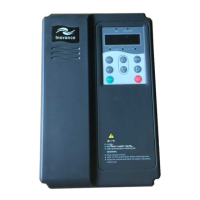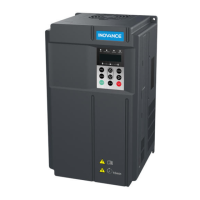
Do you have a question about the Inovance MD320 Series and is the answer not in the manual?
| Control Mode | V/F control, Sensorless vector control (SVC), Torque control |
|---|---|
| Protection Level | IP20 |
| Storage Temperature | -20°C ~ +60°C |
| Cooling Method | Forced air cooling |
| Enclosure Rating | IP20 |
| Output Voltage | 0 ~ Input Voltage |
| Rated Output Current | Depends on model (0.4kW~630kW) |
| Overload Capacity | 150% for 60s |
| Communication Protocol | RS485, Modbus, CANopen |
| Protection Functions | Overcurrent, Overvoltage, Undervoltage, Overheat, Short circuit, Phase loss |
| Ambient Temperature | -10°C~+40°C (with derating) |
| Humidity | ≤95% RH (non-condensing) |
| Altitude | Below 1000m (Derating required above 1000m) |
Provides important safety warnings and general precautions for using the inverter.
Details critical safety measures to be followed before, during, and after installation and operation.
Covers specific operational precautions related to motor, environment, and usage conditions.
Explains the naming convention and product coding system for MD320 series inverters.
Describes the information found on the inverter's nameplate for identification.
Lists the technical data and models available for the MD320 inverter series.
Details the technical specifications, including performance and functional parameters.
Illustrates the physical appearance and provides dimensions for mounting and installation.
Lists and describes available optional parts for the MD320 inverters.
Outlines procedures for routine inspection, cleaning, and maintenance of the inverter.
Explains the warranty terms and conditions for the inverter.
Offers guidance on selecting the appropriate inverter model and control mode for various applications.
Provides guidance on selecting and sizing brake resistors for inverter applications.
Covers environmental requirements and mounting instructions for inverter installation.
Guides on electrical connections, wiring, and external component selection for the inverter.
Introduces the inverter's operation panel, including keys, displays, and indicators.
Explains how to navigate and modify function codes using the three-level menu structure.
Describes the shortcut menu for quick access to commonly used parameters.
Explains how to access extended functions when expansion cards are installed.
Details how to view various status parameters in both stop and running modes.
Explains how to set up and manage user password protection for the inverter.
Guides through the process of automatic motor parameter tuning for optimal vector control performance.
Configures basic inverter functions like model, control mode, and frequency sources.
Sets motor parameters critical for optimal inverter performance and vector control.
Defines electromagnetic compatibility and its importance for electrical equipment.
Outlines the relevant international and national standards for EMC compliance.
Provides practical guidance and precautions for managing electromagnetic interference.
Lists common fault codes, their causes, and recommended troubleshooting steps.
Presents a table of common fault phenomena, their possible causes, and corresponding solutions.
Details the model, specifications, and usage of the common PG card.
Details the MD32PG3 PG card for long-line drive applications.
Explains the features and installation of the MD32IO expansion card.
Describes the MD32MBS communication card for remote serial communication.
Explains the function and operation of the parameter copy card.
Details the serial communication protocol for MD320 inverters.











